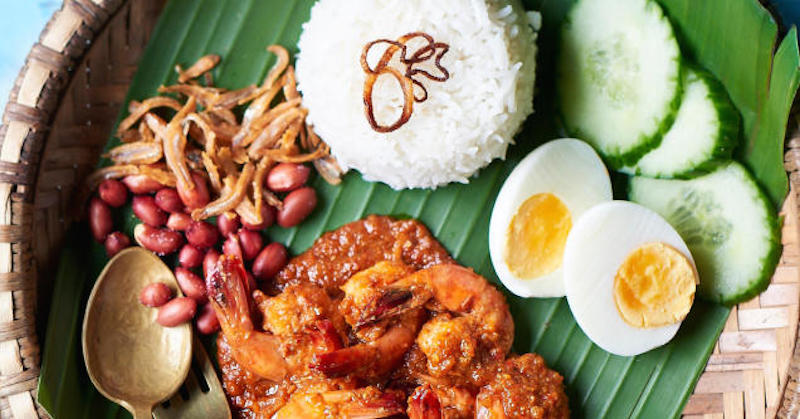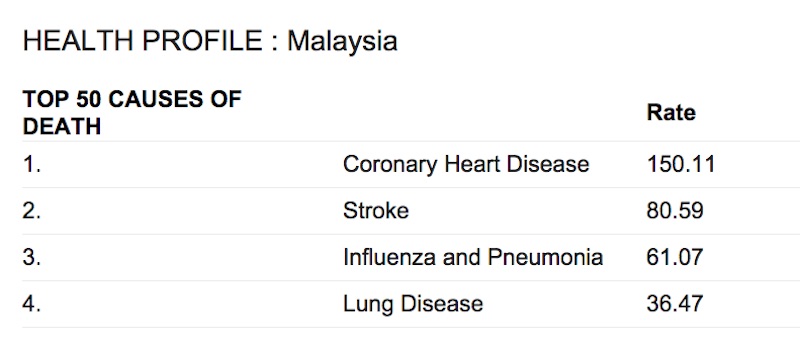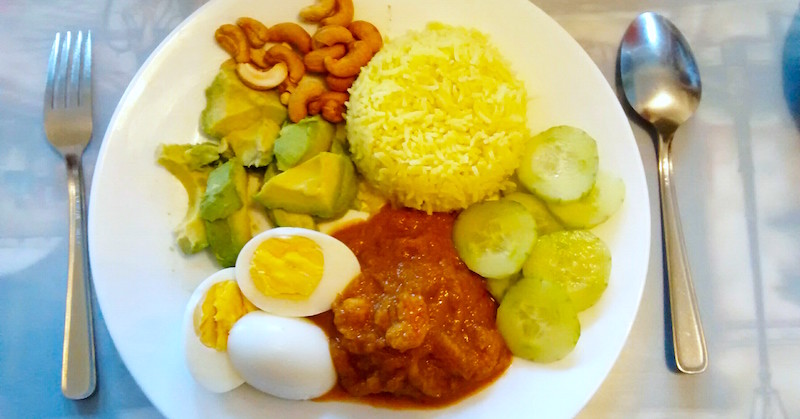Is The Malaysian Dish, Nasi Lemak, Really A Healthy And Balanced Meal?
Last updated on
This article is dedicated to my fellow Malaysians.
On 22 March 2016, The Star paper in Malaysia, reported that “Nasi Lemak” the staple Malaysian dish has been recognized as one of 10 most healthy international breakfasts by TIME Magazine.
The Women’s Health Malaysia wrote to me and asked if I agreed. This is my reply:
Nasi lemak used to be one of my favourite dishes when I was living in KL. I am now residing in Canada and of course, as a Malaysian in a foreign country, I initially had cravings for nasi lemak.
As I couldn’t find any Malaysian restaurant in the small town where I’m currently residing, I researched and created my own version of nasi lemak. Now I can cook the best nasi lemak in my small town here, and my husband and daughter agree!
From my research, I found out for the first time, the ingredients that go into preparing a delicious sambal. I learned from a few Malaysian foodists, but my favorite tutorial video was from Grace Teo of Nyonya Cooking. (Love her pretty dimpled smile!)
This article is not meant to teach you how to cook nasi lemak, but to analyze for you, whether nasi lemak is really healthy or not. You decide for yourself.
Nasi Lemak—The Malaysian Street Version:
I’ll break down the recipe and explain each ingredient used in preparing this dish.
1. White Rice Cooked In Coconut Milk
Health advocates say that white rice is high in carbs, therefore, is unhealthy. Yes, to a certain extent, but I would not totally condemn it. White rice is the staple food of Asians and we are not fat/obese. Westerners generally don’t eat white rice in their culture, yet more than one third of their population are obese. (Ref: “The China Study”).
Healthier version: You can use brown rice in place of white rice. “Kukus” (Steaming) is a better method of cooking than the conventional way of cooking rice in water. Sometimes, my husband makes turmeric rice for my nasi lemak, instead of our regular coconut milk rice.<
2. Coconut Milk—The “Lemak” In The “Nasi Lemak”
Contrary to what Malaysians had been taught, that coconut milk raises cholesterol—that’s not true. More and more researches are showing that coconut milk are healthy fats that actually lower the “bad” cholesterol level.
Coconut oil is saturated fats, one of the most stable cooking oils that can withstand high heat. Coconut oil has many health benefits when consumed in its natural state, and doesn’t turn rancid when used for cooking.
Understanding healing and harmful fats will make your nutritional understanding of food so much clearer.
3. Ingredients For Nasi Lemak Sambal
- Onions or shallots: No problem here. Healthy. Onions are good for the digestive system.
- Dried and fresh chillis: Chillis help to boost metabolism and has a high content of vitamin C and antioxidants.
- Shrimps/prawns, or chicken: As long as they are not commercially farm-raised they are fine. Check with your supplier. Shrimps/prawns or free-range (kampung) chicken, are rich in protein and certain other nutrients.
- Belacan: This is a key ingredient in making nasi lemak sambal tasty. Here is a video on how belacan is made. Not totally hygienic yet I don’t believe any harmful chemicals go into the making of belacan blocks. Only a small amount of belacan is used to make the sambal. You decide.
- Tamarind sauce: This can be homemade (healthy) or used from a commercially-prepared bottled sauce with some artificial preservatives. Only about 2 tablespoons are used for cooking a small pot of sambal.
- Sugar: Most street nasi lemak sambal are sweet. A lot of sugar is used to achieve this sweetness. If you cook your own sambal, you may use jaggery (gula melaka) as a healthier substitute.
- Salt: Table salt is usually used for commercial cooking. For a healthier substitute, I would use Celtic seasalt that is rich in over 80 types of minerals that our body needs. Only a little salt is required.
- Cooking oil: This is where the “big killer” is in the entire dish. A lot of cooking oil is used for cooking the sambal and deep-frying anchovies (ikan bilis) and chicken (if included in recipe). Well, the sambal is usually literally swimming in oil. Most restaurateurs use “regular” or vegetable cooking oil that are polyunsaturated fats (PUFAs). These fats turn rancid easily and are unstable for cooking, even on low heat. When heated, PUFAs turn into harmful transfats that are what cause many chronic diseases like diabetes and heart diseases. This makes most cooking at restaurants, harmful. Is it any wonder that Coronary Heart Disease and Stroke are Malaysia’s top two leading causes of death? (Source: Google.com)
4. Condiments For Nasi Lemak
- Eggs: Many Malaysians still avoid eating eggs or egg yolks, thinking that it is “high in cholesterol”. This is a myth. Eggs (especially from free-range “kampung” hens) are some of the healthiest foods that supply our bodies with good cholesterol. Cholesterol becomes harmful when it gets oxidized from the harmful cooking oil (see explanation above), and other processed/unhealthy foods that we eat. If you have to eat fried eggs, fry them in coconut oil, otherwise, hardboiled eggs for nasi lemak is best.
- Cucumber: Although bland, it is included to reduce the acidity of the dish (also eaten with satay to reduce the carcinogenic carbon). Cucumber also helps to reduce the oxidation caused by the cooking oil, although not enough cucumber is eaten with the dish to have an impactful effect.
- Peanuts: Health advocates will tell you that peanuts are not the best nuts to eat. I use cashew nuts for my healthy version of nasi lemak.
- Anchovies (Ikan bilis): I love those crispy anchovies and they are rich in protein, calcium, iron and many other nutrients. But then again, the cooking oil that they are fried in makes it unhealthy. I use coconut oil for all my cooking.
This is a picture of my “healthy version” of nasi lemak, with added turmeric in the coconut rice. I even added an avocado for its healthy fats (no, it is NOT fattening!). Picture quality is not the best as it is a quick click using my cell phone before I dove into it. Couldn’t wait to eat! 🙂
How Often Can I Eat Nasi Lemak?
This is an interesting question. Each individual is different, so it depends on your overall diet and lifestyle, and the way the dish is prepared. Some of the questions you need to ask yourself:
- Are you eating out a lot? Consider the harmful cooking oil that is used in all that cooking. Even when eating at home, what cooking oil do you use? Switch to coconut oil.
- Do you eat a lot of fresh fruits and vegetables (or drink fresh juices)? These foods are alkalizing and help to neutralize free radicals (oxidants).
- Are you generally living a healthy lifestyle and exercise regularly? Excessive exercise can cause oxidative stress in the body.
- Do you live a rather “stressful” lifestyle? Stress can cause many untold health problems in your gut that is your immune system.
- Do you drink sufficient water daily for your body size? Drinking insufficient water may cause dehydration that leads to many health issues in the long run.
Having said that, I’ll be honest and say that I love my nasi lemak and eat it every now and then (not often). My diet and lifestyle are generally healthy, and I do my occasional juice cleanses and detox. So, there is always a give and take. The choice is yours.
Terima kasih.
Some of the links I post on this site are affiliate links. If you go through them to make a purchase, I will earn a small commission (at no additional cost to you). However, note that I’m recommending these products because of their quality and that I have good experience using them, not because of the commission to be made.
Comments
Leave a Reply



































 JOIN OVER
JOIN OVER
TERBAIK!!! Salam dari Malaysia 🙂
Adding some steamed kangkung or spinach adds a complementary flavor, texture, and nutritional component.